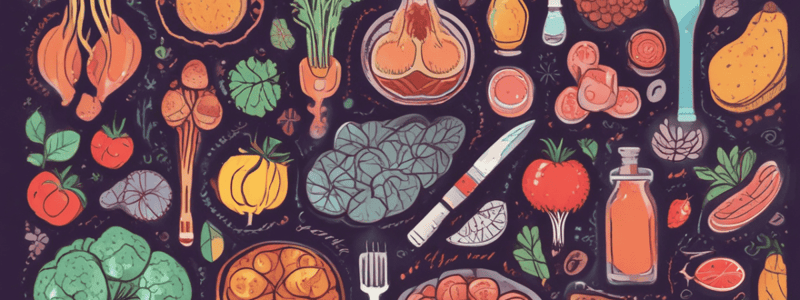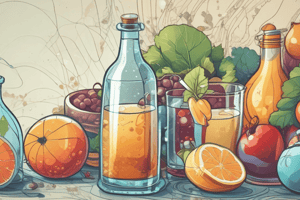Podcast
Questions and Answers
What is the primary function of lipoprotein lipase?
What is the primary function of lipoprotein lipase?
- To convert free fatty acids into triglycerides
- To synthesize triglycerides in the liver
- To transport cholesterol to peripheral tissues
- To break down chylomicrons into free fatty acids and glycerol (correct)
What happens to chylomicrons after they deliver triglycerides to tissues?
What happens to chylomicrons after they deliver triglycerides to tissues?
- They are converted into VLDLs
- They are excreted in the urine
- They are taken up by the liver as chylomicron remnants (correct)
- They are broken down into glycerol and free fatty acids
What is the main function of VLDLs?
What is the main function of VLDLs?
- Transporting cholesterol to peripheral tissues
- Storing triglycerides in adipose tissue
- Breaking down triglycerides into free fatty acids
- Transporting triglycerides to peripheral tissues (correct)
How are free fatty acids utilized in muscle tissue?
How are free fatty acids utilized in muscle tissue?
What is the process of breaking down triglycerides in adipose tissue called?
What is the process of breaking down triglycerides in adipose tissue called?
What are the two main products of lipolysis?
What are the two main products of lipolysis?
Which of the following is NOT a type of lipoprotein?
Which of the following is NOT a type of lipoprotein?
What happens to VLDLs as triglycerides are removed?
What happens to VLDLs as triglycerides are removed?
Which enzyme is responsible for the breakdown of triglycerides in adipose tissue?
Which enzyme is responsible for the breakdown of triglycerides in adipose tissue?
What is the role of albumin in the process of fatty acid transport?
What is the role of albumin in the process of fatty acid transport?
What is the primary function of coenzyme A (CoA) in fatty acid metabolism?
What is the primary function of coenzyme A (CoA) in fatty acid metabolism?
Where does beta-oxidation take place?
Where does beta-oxidation take place?
What is the primary product of each cycle of beta-oxidation?
What is the primary product of each cycle of beta-oxidation?
What is the role of the citric acid cycle in the process of fatty acid oxidation?
What is the role of the citric acid cycle in the process of fatty acid oxidation?
Which of the following molecules directly contributes to the proton gradient that drives ATP synthesis in oxidative phosphorylation?
Which of the following molecules directly contributes to the proton gradient that drives ATP synthesis in oxidative phosphorylation?
Which of the following statements is NOT true about the process of fatty acid oxidation?
Which of the following statements is NOT true about the process of fatty acid oxidation?
Which enzyme is NOT involved in the carnitine shuttle for fatty acid transport?
Which enzyme is NOT involved in the carnitine shuttle for fatty acid transport?
During which process do fatty acids get broken down into acetyl-CoA?
During which process do fatty acids get broken down into acetyl-CoA?
What is the primary energy currency produced during the citric acid cycle?
What is the primary energy currency produced during the citric acid cycle?
Triglycerides are composed of which molecular structure?
Triglycerides are composed of which molecular structure?
What happens to triglycerides after they are digested and absorbed in the small intestine?
What happens to triglycerides after they are digested and absorbed in the small intestine?
How are chylomicrons transported from the intestines to the bloodstream?
How are chylomicrons transported from the intestines to the bloodstream?
Which statement about triglycerides is incorrect?
Which statement about triglycerides is incorrect?
Which component is synthesized alongside triglycerides during their formation?
Which component is synthesized alongside triglycerides during their formation?
What is the primary function of hormone-sensitive lipase in the transport of fatty acids?
What is the primary function of hormone-sensitive lipase in the transport of fatty acids?
Why do free fatty acids bind to albumin for transport in the blood?
Why do free fatty acids bind to albumin for transport in the blood?
What is the role of fatty acid translocase (FAT/CD36) in fatty acid transport?
What is the role of fatty acid translocase (FAT/CD36) in fatty acid transport?
What is the purpose of activating fatty acids to form fatty acyl-CoA?
What is the purpose of activating fatty acids to form fatty acyl-CoA?
Which of the following is NOT a key step in the transport of fatty acids within the body?
Which of the following is NOT a key step in the transport of fatty acids within the body?
What is the primary function of fatty acid binding proteins (FABPs)?
What is the primary function of fatty acid binding proteins (FABPs)?
What is the role of acyl-CoA synthetase in the transport of fatty acids?
What is the role of acyl-CoA synthetase in the transport of fatty acids?
Where does the breakdown of triglycerides into free fatty acids and glycerol occur?
Where does the breakdown of triglycerides into free fatty acids and glycerol occur?
Flashcards
What are fatty acids?
What are fatty acids?
Long chains of hydrocarbon molecules with a carboxyl group (-COOH) at one end. They are key components of fats and oils in plants and animals, and they are classified by the number of double bonds.
How are fatty acids released from adipose tissue?
How are fatty acids released from adipose tissue?
Hormone-sensitive lipase breaks down triglycerides into free fatty acids and glycerol when energy is needed.
How are fatty acids transported in the blood?
How are fatty acids transported in the blood?
Free fatty acids are not water-soluble, so they bind to albumin for transport in the bloodstream.
How are fatty acids taken up by cells?
How are fatty acids taken up by cells?
Signup and view all the flashcards
How are fatty acids transported into mitochondria?
How are fatty acids transported into mitochondria?
Signup and view all the flashcards
What happens to fatty acids during beta-oxidation?
What happens to fatty acids during beta-oxidation?
Signup and view all the flashcards
How is energy produced from fatty acids?
How is energy produced from fatty acids?
Signup and view all the flashcards
What are triglycerides?
What are triglycerides?
Signup and view all the flashcards
How are triglycerides formed?
How are triglycerides formed?
Signup and view all the flashcards
How are dietary triglycerides digested?
How are dietary triglycerides digested?
Signup and view all the flashcards
How are digested triglycerides absorbed and re-formed?
How are digested triglycerides absorbed and re-formed?
Signup and view all the flashcards
How are absorbed triglycerides packaged?
How are absorbed triglycerides packaged?
Signup and view all the flashcards
How are chylomicrons transported?
How are chylomicrons transported?
Signup and view all the flashcards
How are triglycerides in chylomicrons broken down?
How are triglycerides in chylomicrons broken down?
Signup and view all the flashcards
What happens to the breakdown products of chylomicron triglycerides?
What happens to the breakdown products of chylomicron triglycerides?
Signup and view all the flashcards
What happens to chylomicron remnants?
What happens to chylomicron remnants?
Signup and view all the flashcards
What is the function of VLDL?
What is the function of VLDL?
Signup and view all the flashcards
What happens to VLDL over time?
What happens to VLDL over time?
Signup and view all the flashcards
What happens to free fatty acids released by lipoprotein lipase?
What happens to free fatty acids released by lipoprotein lipase?
Signup and view all the flashcards
What is lipolysis?
What is lipolysis?
Signup and view all the flashcards
How are free fatty acids transported after lipolysis?
How are free fatty acids transported after lipolysis?
Signup and view all the flashcards
What happens to free fatty acids before beta-oxidation?
What happens to free fatty acids before beta-oxidation?
Signup and view all the flashcards
What happens during beta-oxidation?
What happens during beta-oxidation?
Signup and view all the flashcards
What happens to acetyl-CoA after beta-oxidation?
What happens to acetyl-CoA after beta-oxidation?
Signup and view all the flashcards
How is ATP produced from NADH and FADH2 generated in beta-oxidation?
How is ATP produced from NADH and FADH2 generated in beta-oxidation?
Signup and view all the flashcards
Study Notes
Fatty Acids
- Long chains of hydrocarbon molecules with a carboxyl group (-COOH) at one end.
- Key components of fats and oils in plants and animals, classified by the number of double bonds.
Transport of Fatty Acids
- Release from Adipose Tissue: Hormone-sensitive lipase breaks down triglycerides into free fatty acids and glycerol when energy is needed.
- Transport in Blood: Free fatty acids are not water-soluble, so they bind to albumin for transport in the bloodstream.
- Uptake by Cells: Cells utilize specific transport proteins like fatty acid translocase (FAT/CD36) and fatty acid binding proteins (FABPs) to absorb free fatty acids.
- Transport into Mitochondria: Fatty acids convert to fatty acyl-CoA via acyl-CoA synthetase, requiring the carnitine shuttle for transport into mitochondria.
- Beta Oxidation: In mitochondria, fatty acids are oxidized, producing acetyl-CoA, which enters the citric acid cycle (Krebs cycle) for ATP production.
- Energy Production: ATP generated from the citric acid cycle and electron transport chain powers various cellular functions.
Triglycerides
- Composed of one glycerol molecule bonded to three fatty acid chains; the most common fat type in the body.
- Formed when excess calories are converted to fat for storage in fat cells.
Transport of Triglycerides
- Absorption and Packaging:
- Digestion: Dietary triglycerides break down into monoglycerides and free fatty acids in the small intestine by pancreatic lipases.
- Absorption: These products are absorbed by enterocytes and re-esterified into triglycerides.
- Chylomicron Formation: Packaged into chylomicrons with cholesterol, phospholipids, and apolipoproteins.
- Transport via Lymphatic System and Bloodstream: Chylomicrons enter the lymphatic system and are transported to the bloodstream via the thoracic duct.
- Uptake by Tissues:
- Lipoprotein lipase on endothelial surfaces breaks down triglycerides in chylomicrons into free fatty acids and glycerol for cellular uptake.
- Free fatty acids are used for energy or storage, while glycerol returns to the liver.
- Liver Processing:
- Chylomicron remnants are taken up by the liver to form very-low-density lipoproteins (VLDL) for further transport.
- Very-Low-Density Lipoproteins (VLDL) Transport:
- Released into the bloodstream to transport triglycerides to peripheral tissues.
- VLDL is acted upon by lipoprotein lipase, forming intermediate-density lipoproteins (IDL) and low-density lipoproteins (LDL) over time.
- Storage and Utilization:
- Free fatty acids can be re-esterified in adipose tissue or oxidized in muscle for energy.
Release of Energy from Triglycerides and Fatty Acids
- Lipolysis: Breakdown of triglycerides into glycerol and free fatty acids, catalyzed by hormone-sensitive lipase (HSL) and adipose triglyceride lipase (ATGL).
- Transport: Free fatty acids are transported by albumin to various tissues.
- Fatty Acid Activation: Free fatty acids are activated to acyl-CoA in the cytoplasm, a process requiring ATP.
- Beta Oxidation: Acyl-CoA enters mitochondria for beta-oxidation, producing acetyl-CoA, NADH, and FADH2.
- Citric Acid Cycle (Krebs Cycle): Acetyl-CoA undergoes further oxidation, producing additional NADH, FADH2, ATP, and carbon dioxide.
- Electron Transport Chain (ETC) and Oxidative Phosphorylation: NADH and FADH2 donate electrons to the ETC, creating a proton gradient that drives ATP synthesis through oxidative phosphorylation.
Studying That Suits You
Use AI to generate personalized quizzes and flashcards to suit your learning preferences.



